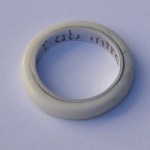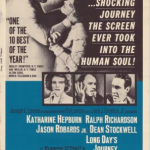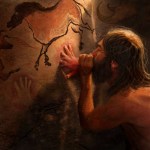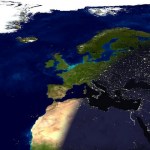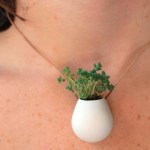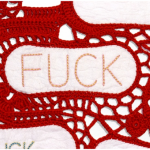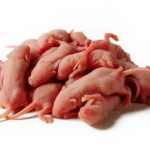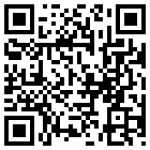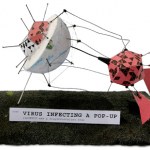biology
Reader Laura alerted me to a self-described "weird art & style blog" that many of you may enjoy - it's called Synesthesia Garden. A recent topic was custom lab-grown bone wedding rings (above):
Harriet Harriss, one of the participants, says: "I love the idea that it's precious only to us because it is, literally, us. It's almost worthless to anyone else. To take something that is from myself and make it into something precious is a lovely thing and means quite a lot to me."
She has also recently covered Nita Collins' scarred, grotesquely plaintive art dolls and Nicola Samori's faceless…
Last Wednesday I saw the first snowdrop. Last Saturday I heard the first blackbird evensong. Magpies are making these soft chirping noises that spell "let's get it on". This morning it was above 5 Celsius in the shade, and I skipped my long-johns for the first time this year. And when I went out the door, my daughter pointed out the first scilla bud. Spring is here!
Dear Reader, if you're in the northern hemisphere, what signs of spring have you seen?
The federal government, including NIH, isn't exactly seen as a hotbed of artsy drama types. ("Faceless gray mega-bureaucracy" might be a more typical descriptor.) So I was tickled to learn that the National Institute on Drug Abuse is framing a series of continuing medical education (CME) courses about addiction around dramatic readings of Eugene O'Neill's Long Day's Journey Into Night. And no, we're not talking about cheesy readers' theater - they got Debra Winger and several Tony nominated stage actors to participate.
As a threshold matter, this is cool because it shows that NIH recognizes…
I guess it's not surprising, my dopamine is rising
And my glutamate receptors are all shot
I'd surely be bemoaning all the extra serotonin
But my judgement is impaired and my confidence is not
Allosteric modulation
No Long Term Potentiation
Hastens my inebriation
Give me a beer. . .
Physiology professors, I trust you know what to do with this holiday treasure by cadamole. Nothing makes neurobiology seem relevant like a beer.
Via Laughing Squid, we learn that students at the UK's Strode College were tasked with building outfits from cardboard packaging, and one created this whimsical number. If they'd just incorporate the technology from these prosthetic tentacles, this would be the greatest thing ever.
David Clarke, president of the DC chapter of the Guild of Natural Science Illustrators (a great group that I considered joining once, long ago and several careers away), just passed along an invitation to an event next week. The artists who created the work in the Smithsonian's NMNH Hall of Human Origins will be talking about their process, the science behind it, the equipment they use and the working of their studios. While this is the DC GNSI meeting, they are graciously opening it to the public, so if you are in the DC area, consider attending.
More info about the event below the fold.…
For some perspective on yesterday's story about MRSA and other bugs found on BART train seats, let's turn to Good Magazine, which interviews microbiologist Pat Fidopiastis about a separate study, funded by Clorox, which found bacteria on shopping cart handles. Fidopiastis writes:
none of this means much unless you can show me a significant risk involved with coming in contact with a shopping cart. You might be able to say that "X percent" more kids get sick if they touch a shopping cart handle versus a bathroom door knob, for example. But what are the actual numbers? Is this like saying, "…
As someone who rides BART to work when I don't bike, this is a disturbing finding: On BART Trains, the Seats Are Taken (by Bacteria):
The Bay Citizen commissioned Darleen Franklin, a supervisor at San Francisco State Universityâs biology lab, to analyze the bacterial content of a random BART seat. The results may make you want to stand during your trip.
Fecal and skin-borne bacteria resistant to antibiotics were found in a seat on a train headed from Daly City to Dublin/Pleasanton. Further testing on the skin-borne bacteria showed characteristics of methicillin-resistant staphylococcus…
It's strangely artistic, like a Dutch still life: this disturbing short film by Sam-Taylor Wood defies our expectations of decomposition, as a rabbit churns with decay while a peach sitting nearby remains fresh. (Video below the fold, so as not to gross anyone out by surprise).
Via wouldn't you like to see something strange - there's a second video over there, though not as creepy as this one.
"I'll do my dreaming with my eyes wide open, and I'll do my looking back with my eyes closed." -Tony Arata
Would you believe me if I told you that -- in terms of your own eyes -- you saw better at night than you did during the day?
It's true! But it doesn't have much to do with the amount of light available. When you're looking out at distant objects, you'd love to be able to resolve them with your eyes.
For example, that object in the distance, down the road in the image above? Is it a motorcycle with one headlight, a car or truck with two, or (I hope not!) a train with three?
Well, with…
Kissing remains popular among the people of the world, and in a new book former scibling Sheril Kirshenbaum delves into the emerging science behind the age-old practice. For one, the sensory experience of osculation (as sucking face is more formally known) forges new neuronal connections in the brain. On Dean's Corner, Dr. Jeffrey Toney says "these new connections represent learning, memory and can enhance sensory perception and even healing." We at Scienceblogs recommend five to nine servings a day. Dr. Toney also shares a video which demonstrates affection throughout the animal kingdom…
We've been buried under ice, snow, and slush up here in Massachusetts for months, and the chlorophyll deprivation is brutal. The other day I was chatting with someone, and he suddenly tuned out of our conversation, gazing into the distance wistfully. "Oh, sorry," he said, "I just noticed I can see some grass over there."
If only I'd known months ago about Colleen Jordan. Her tiny plant necklaces are little green reliquaries of summer, so you can always look down and see leaves - even in February in Boston.
Sadly, the necklaces (which are 3D-printed polymer and start at $55) don't come with…
Okay, I knew that planets are big, intellectually, but a well-done graphic is worth a thousand words, and a pretty HD video is even better. Brad Goodspeed made this video to suggest what other planets would look like, if they orbited Earth at the same distance as the Moon does. I've embedded it, but you should seriously watch it in HD, full-screen for maximum effect.
Scale from Brad Goodspeed on Vimeo.
I have nightmares like that. Seriously. But is the video accurate?
In addition to being full-on creepy, Brad's video produced a fascinating discussion in the comments and on various sites…
Remember the synthetic biology documentary I blogged about a while back? Well, the filmmakers are still working toward their goal. They have a little less than a month left, and I just noticed that they've seriously beefed up the rewards you can get for funding them. There are some interesting gifts from $10 up, but now at $300$1000*, they will send you a rough cut, solicit your input, and credit you in the final version. For everyone concerned about how scientists appear in the film, this is an intriguing option!
*Correction -the cost is actually $1000. For some reason Kickstarter bins all…
PMS Quilt, 2008
hand embroidered and crocheted pantyliners
Laurel Roth
Yes, that is just what it says it is: a collection of pantyliners embroidered with profanity.
One thing is clear about artist Laurel Roth: she is not afraid to make viewers uncomfortable. Her series "Hope Chest" is constructed of hygenic accessories embroidered with "off-kilter reflections on biology, fertility, and the ever-changing roles of women" - like the f-word. Embellished with beads, rose thorns, and crochet, the embroideries are twee, kitschy decor - or they would be, if not for their bluntly worded messages.…
Pinkies
from Food Chain: Encounters Between Mates, Predators and Prey by Catherine Chalmers
Photographer Catherine Chalmers (who may be best known in biology circles for her portraits of genetically modified mice) goes beyond brutal accuracy in her animal photography. Food Chain: Encounters Between Mates, Predators and Prey is a book of photos depicting predatory insects, frogs, and snakes devouring their living meals - including naked, squirming baby mice (above). It's no more than honest about what animals do and eat (yes, "cute" frogs will eat baby mice). But Chalmers' ordering and…
Dark pictures, thrones, the stones that pilgrims kiss,
poems that take a thousand years to die
but ape the immortality of this
red label on a little butterfly.
- excerpt from Vladimir Nabokov's "On Discovering a Butterfly"
It's not very well known that novelist Vladimir Nabokov, author of Lolita, was also a lepidopterist; for six years, he was a Research Fellow at the Harvard Museum of Comparative Zoology (now part of the HMNH). Carl Zimmer recounts in the NYT how Harvard professor Naomi Pierce recently set out to test Nabokov's hypotheses about blue butterfly speciation, and discovered…
I think DNA is amazing. I think biotech inspires great design. And if you've read this blog at all, you know I love sciart. But I just cannot understand the new infogenetics product from DNA 11 - the company behind that trendy gel electrophoresis wall art. While I'd normally just say "I don't get it" and move on, DNA 11 claims that their "augmented art" is "the ultimate intersection of biology, art and technology." I don't know how that could get more squarely in the BioE wheelhouse. So let's take a closer look at how, exactly, biology and art intersect in the "Ancestry Portrait" (pictured…
From NextNature, an intriguing post about the Institute for Digital Biology:
During the exhibition, visitors were able to feed a colony of microscopical pop-up creatures, save Chinese websites from a pageview-shortage, preserve an Amazone tribe from extinction by subscribing to its homepage and view a short documentary on how the living internet established itself.
Artist Walewijn den Boer also created a peculiar, twelve-minute faux-documentary, which uses animation to bring his digital biology concepts into meatspace (check it out below the fold).
Update 1:
I think the clunkiness of the…
